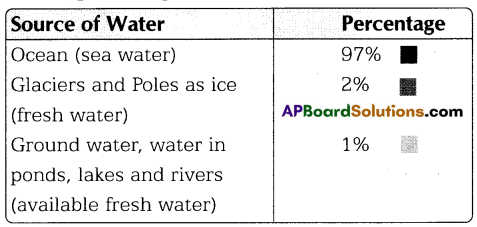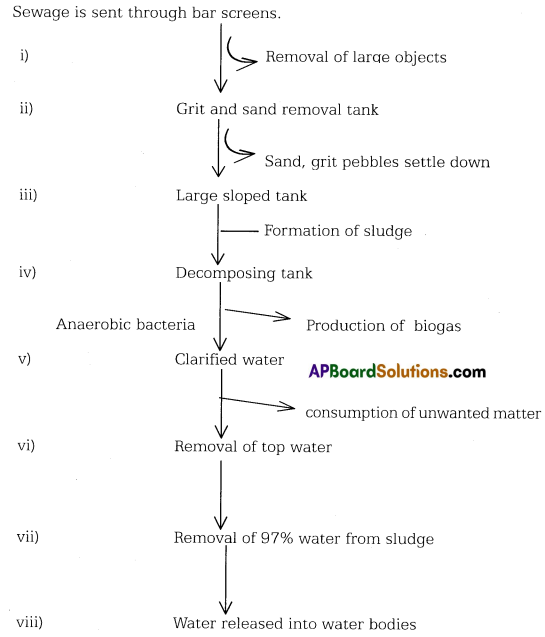These TS 7th Class Science Important Questions 14th Lesson Water: Too Little to Waste will help the students to improve their time and approach.
TS 7th Class Science Important Questions 14th Lesson Water: Too Little to Waste
Question 1.
Write the percentage of different water resources available on the earth.
Answer:

Question 2.
What is decade of water conservation? On which day is the world water day declared?
Answer:
The period 2005 – 2015 was declared as the International Decade for action on “Water for life”. On 22nd March, 2005 it was declared as world water day.
![]()
Question 3.
What are the contaminants mainly present in sewage water.
Answer:
Sewage water contains inorganic, organic and bacterial as well as other microbial contaminants.
Question 4.
What are the contaminants of sewage ? Classify them.
Answer:
The impurities present in the sewage are called contaminants.
The impurities or contaminants of sewage are classified as 3 types.
- Organic impurities: Human feces, animal waste, oil, urea, pesticides, herbicides, fruit and vegetable wastes etc.
- Inorganic impurities: Nitrates, phosphates, metals etc.
- Bacteria and other microbes : These cause cholera, typhoid, dysentery etc.
Question 5.
What are some ways of disposing sewage?
Answer:
- We dispose waste water in our daily life in different ways and means.
- We often see water stagnated near borewells or beside houses. Sometimes, human and animal excretions also mix with this water.
- We get a foul smell when we walk near those areas. To prevent this, we need a proper drainage system.
- In some villages and towns, we can see drainage canals on both sides of the streets to maintain flow of waste water.
Question 6.
What is meant by sewage?
(or)
Define sewage.
Answer:
All the waste water released by homes, industries, hospitals,offices and other users is collectively called sewage.
![]()
Question 7.
What are the sources of sewage?
Answer:
Homes, hospitals, offices etc.
Question 8.
What is the chemical substance used for killing microbes in waste water.
Answer:
Chlorine kills the harmful disease causing organisms present in waste water.
Question 9.
What are the calamities we see due to over extraction of fresh water in future?
Answer:
- Unsustainable extraction of fresh water causes water scarcity.
- Due to over extraction of fresh water, underground reserves are falling rapidly.
- In India, the water table has fallen more than 300 metres.
- People may find difficult even to get water for drinking.
- There will be wars among states, regions and countries for water resources.
- Hence, every one should remember to conserve alternate water resources.
Question 10.
If you are allowed to visit a sewage treatment plant, what doubts you can clarify about the plant from technicians?
Answer:
- What is the process of filtering sewage?
- How much time is taken for filtering sewage?
- Can we implement the same process on our own at home?
- What is the cost of treatment for a day?
Question 11.
What are the materials used for observing changes in waste water at treatment plants.
Answer:
Glass jar, dirty organic matter, ink drops, aerated device, filter papers, chlorine etc.,
![]()
Question 12.
Read the table and answer the question that follows.
Answer:
| Source of water | Percentage of water |
| Oceans | 97% |
| Glaciers & Poles as Ice | 2% |
| Ground water, lakes. rivers, streams etc. | 1% |
i. What is the nature of 97% of oceanic water?
ii. The type of water present in the glaciers?
iii. How are we using fresh water at present?
iv. Where do we obtain readily available water ?
Answer:
i. Saline water
ii. Fresh water resources
iii. People use fresh water very indiscriminately.
iv. We obtain water from rivers, streams, bore wells etc.
Question12.
Draw a pie diagram based on the percentages of water resources on the earth given below (oceanic water – 97%; Glaciers. polar region 2%; Ground water, lakes and rivers and other fresh water bodies.
Answer:
Source of water on earth

Question 13.
Draw a flow chart showing different stages in treatment of sewage.
Answer:

![]()
Question 14.
People consume fresh water resources indiscriminately. Plenty of water is wasted even in highly educated areas. Then, you worried about the situation. You wanted to convey them about importance of water and future problem of water resources. You and your classmates planned to conduct a campaign on water conservation. What are the suggested slogans to be created to bring the awareness in the community? Write few of them.
Answer:
- Water — future huge matter
- Save every drop — generation will be top
- Today’s water saving – Tomorrow’s great feeling.
- I save water source – You too do for future.
Choose the correct answer:
I. Conceptual Understanding
Question 1.
The following chemical kills harmful disease causing organisms present in sewage ( )
A) Chlorine
B) Fluorine
C) Iodine
D) Hydrogen
Answer:
A) Chlorine
Question 2.
Water should be before being released into water bodies.
A) polluted
B) boiled
C) treated
D) poisoned
Answer:
C) treated
Question 3.
Aeration allows growth of that break down wastes. ( )
A) plants
B) microbes
C) chemicals
D) animals
Answer:
B) microbes
![]()
Question 4.
These also help in waste water disposal ( )
A) Reservoirs
B) Rivers
C) Streams
D) Septic ranks
Answer:
D) Septic ranks
Question 5.
The percentage of water in activated sludge ( )
A) 90%
B) 95%
C) 97%
D) 87%
Answer:
C) 97%
Question 6.
Liquid wastes released from houses and offices. ( )
A) medicated
B) sewage
C) purity
D) fertile water
Answer:
B) sewage
Question 7.
The percentage of available fresh water on the land. ( )
A) 97%
B) 3%
C) 4%
D) 1%
Answer:
D) 1%
Question 8.
Treatment of waste water involves process ( )
A) physical
B) chemical
C) biological
D) Above all
Answer:
D) Above all
![]()
Question 9.
Untreated sewage water is a source for ( )
A) diseases
B) plants
C) people
D) All animals
Answer:
A) diseases
Question 10.
World Water Day is celebrated on ( )
A) March 19
B) March 10
C) March 22
D) March 05
Answer:
C) March 22
Question 11.
Dried sludge is used as ( )
A) waste material
B) manure
C) cattle food
D) fuel
Answer:
B) manure
Question 12.
Types of drainage systems. ( )
A) Open
B) Closed
C) Underground
D) A, B and C
Answer:
D) A, B and C
II. Asking Questions and Making Hypothesis
Question 13.
Sewage combined with drinking water bodies results in … ( )
A) diseases to the people
B) cleaning up of water
C) water storage
D) water filtration
Answer:
A) diseases to the people
![]()
Question 14.
Find out the correct statement. ( )
A) Nitrates are one of the impurines of sewage
B) Sewage is more in rural areas
C) Sewage water is useful for crop plants.
D) Draining out sewage water is good method for cleaning the area.
Answer:
D) Draining out sewage water is good method for cleaning the area.
Question 15.
One of the following is not water conserving methods. ( )
A) Check dam
B) Contour trenches
C) Canal water system
D) Percolation tanks
Answer:
C) Canal water system
III. Experimentation and Field lnvestigation
Question 16.
A simple technique that breaks down waste material and helps in growth of organisms. ( )
A) Percolation technique
B) Filtration method
C) Aeration
D) Sublimation
Answer:
C) Aeration
Question 17.
What will we observe in the third stage of sewage water treatment plant? ( )
A) Residue
B) Sludge
C) Filtered water
D) Sewage water
Answer:
B) Sludge
Question 18.
The percentage of water in the sludge ( )
A) 51%
B) 32%
C) 97%
D) 46%
Answer:
C) 97%
![]()
Question 19.
The disinfectants used by us in the water. ( )
A) Benzene
B) Chlorine
C) Phosphene
D) Rainine
Answer:
B) Chlorine
IV. Information Skills and Projects
Question 20.
Read the table and answer the question.
| Water sources | Percentage |
| Oceanic water Glaciers and Polar regions Ground water, ponds, lakes and rivers |
97% 2% 1% |
Q. Out of all the resources, how much of water is available in glaciers and polar regions. ( )
A) 2%
B) 1%
C) 97%
D) 3%
Answer:
A) 2%
Question 21.
Read the paragraph and answer the question.
[Physical chemical and biological processes are involved In treatment waste water at the treatment plants.
Q. Repeated filterings of aerated liquid is process. ( )
A) biological process
B) physical process
C) chemical process
D) all the above
Answer:
B) physical process
![]()
Question 22.
In order to drain stagnant water, we should maintain ( )
A) proper water plants
B) proper sawage towers
C) proper drainage system
D) improper aeration
Answer:
C) proper drainage system
V. Communication through Drawing and Model Making
Question 23.
Sewage water passed through→ ?
→ Sand removal tank → large tank→ pumping of air.
Pick up the missing one in the ‘7’ mark ( )
A) iron bars
B) aerated tank
C) sludge
D) sewage
Answer:
A) iron bars
VI. Appreciation and Aesthetic Sense and Values
Question 24.
In order to review forest area, we can manage ( )
A) reservoirs
B) percolation tanks
C) check dams
D) all the above
Answer:
D) all the above
VII. Application to Daily Life and Concern to Bio Diversity
Question 25.
The waste water management seen in our houses is ( )
A) draining out the water
B) septic tank
C) over head tanks
D) underground water
Answer:
A) draining out the water
![]()
Question 26.
Conserving water is a duty of ( )
A) an individual
B) community
C) A and B
D) government
Answer:
C) A and B